#i always have more than one window open so sai is never in fullscreen
Text
Hex shards of fate all cards

#Hex shards of fate all cards free
This bundle comes with a total of 6 boosters from the ninth card set in HEX, “Doombringer”. Paired with 10 pieces of shiny equipment to enhance your cards on the battlefield, this collection gives you the tools to survive the mysterious Enders which are invading the Frost Ring Arena. Additionally, there are a few consumables and one of our rare cosmetics in this pack – as well as some in-game currency to give you a little boost. Install HEX: Shards of Fate on Steam to be able to use the contents within this bundle. This card set comes with new keywords: “Fusion”, “Rowdy”, and “Rabid,” "Rebirth," and "Feral."Įquipment is one of the great innovations HEX brought about in the Trading Card Game genre, made possible by the digital nature of the game. Items modify your cards by altering their attributes or effects, and giving you another option to customize your deck. Equipment can be acquired on your many adventures, through victory in battle, opening treasure chests, and completing quests in the campaign. Thanks for the tip, Platinum Article taken from come in varying rarities, similar to cards and improve or enhance your already powerful cards. It should be noted that currently there’s no auto-patching on Linux so you’ll need to redownload the latest build to update. You can try these unofficial builds for yourself here. I wouldn’t hold my breath expecting them to change their tune anytime soon but perhaps with enough time and interest in their unofficial builds they may reconsider the issue. It’s a shame that they don’t plan on supporting it officially for now, but at least it’s not a hard “never”. Unfortunately, while we are more than happy to release our unofficial build for Linux enthusiasts, we don’t have plans for an official Linux release at this time. I reached out to the developer asking if there were any plans to bring the game officially to Linux in any form and got the following reply: Outside of the fullscreen Unity bug (which is prevented by default because the game launches in windowed mode), I haven’t encountered a single technical issue. These aren’t directly backed by the development team and is pretty much distributed as-is. Since late last year, unofficial Linux builds have been available in the Hex forums. I can't really say if the competitive mode is properly balanced as I've spent most of my time engrossed with the single player content. There’s also an auction house where players can buy and sell cards with the in-game (non-premium) currency, so building the deck you really want isn’t too onerous.
#Hex shards of fate all cards free
Hex is also a free to play game with somewhat familiar mechanics of getting drops from playing against other players as well as levelling up in the campaign mode. In the little that I've seen of the lore and world, it's been somewhat interesting to learn about and to adapt my deck and strategies to all sorts of different scenarios. Sure, there's still staples like elves and humans but there's also more atypical factions like evil rabbits and nomadic coyotes. It's a colorful world filled with all sorts of creatures and types of cards, with the occasional interesting twist on how their fantasy creatures are represented with the types of mechanics they prefer. I’ve already lost a few hours enjoying the different challenges and discovering the interesting mix of RPG elements that you get to play around with with your avatar. Perhaps more interestingly, at least to people like me who prefer playing on their own, Hex also features a campaign mode for singleplayer exploits. Hex borrows a lot from the very successful Magic: The Gathering card game (so much so they settled a lawsuit with Magic owner Wizards of the Coast) but adds its own little twists and updates that take advantage of the digital-only format of the game. I’ve played a lot of TCGs in my day and have been around a lot of people who are obsessive about them so I always appreciate trying out a different take on the genre. YouTube videos require cookies, you must accept their cookies to view.

0 notes
Text
Macbook air 13 inch battery life 2013

MACBOOK AIR 13 INCH BATTERY LIFE 2013 PORTABLE
MACBOOK AIR 13 INCH BATTERY LIFE 2013 PC
MACBOOK AIR 13 INCH BATTERY LIFE 2013 TV
MACBOOK AIR 13 INCH BATTERY LIFE 2013 MAC
This 13-inch MacBook Air maintains its wedge-shaped profile, a maximum of 0.68 inch thick at the back tapering down to a 0.11-inch terminal edge at the front. Is this the result of priorities being committed elsewhere? Or, is it simply a case of "if it ain't broke, don't fix it"? We'll let the reader decide on that front, and while we tend to lean toward the latter option, the net result is the same: we won't spend an awful lot of time describing this now-familiar machine.
MACBOOK AIR 13 INCH BATTERY LIFE 2013 PC
That's in part because of the success of the MacBook Air - we see them popping open on trains and airplanes all the time these days - but largely this is thanks to Apple not significantly revamping the design for nearly three years, a period over which we've seen radical changes on the PC side of things. What once was a fresh and exciting design has now, it must be said, become rather familiar. Is it the world's best laptop to date? I have to say yes, as I've never seen any other all-in-one experience quite as fluid and fantastic.Is the unchanged design the result of priorities being committed elsewhere? Or, is it simply a case of "if it ain't broke, don't fix it"? I'm more productive and more mobile thanks to it. For somebody coming from a new-ish Dell or HP to this, it may not be as magical, but to me the Air is revolutionizing my computing.
MACBOOK AIR 13 INCH BATTERY LIFE 2013 PORTABLE
In other words, I'm 99% happy with the screen real estate as it is that I don't bother to attach anything larger.I've only ever owned a few other laptops, and certainly not had one that actually qualifies as a portable device in today's standards.
MACBOOK AIR 13 INCH BATTERY LIFE 2013 TV
I imagine that when I buy an Apple TV and Mavericks is released I'll be using a display wirelessly a lot, but the need to use a bigger screen hasn't yet outweighed the (minimal) effort to connect it to one. I bought the thunderbolt to DVI adapter so as to spread across to my 23" monitor, but I've only used it once. While I can't imagine I could cope with a display as small as the 11" one, 13" on this is ample.
MACBOOK AIR 13 INCH BATTERY LIFE 2013 MAC
With Mac OS' multiple desktops, fullscreen applications, and exposé, I haven't felt cramped once. I do wish I had bought a Magic Mouse as it would be useful to whip out a mouse for some tasks (and the PC mice I have aren't as portable), but it's a more than bearable situation.Another thing I always disliked about laptops was how cramped the screens seem (I like to think I have 'digital claustrophobia' and have always needed at least two monitors for my desktop PC so that I have breathing space. After turning all the gestures on, I can get most things done about as quickly as I'd get them done with a mouse. The trackpad on the Air however is the most usable I've ever experienced. I find a mouse much easier to use, especially with graphical tasks (or games). Not only is Apple aiding the environment in their usual eco-friendly manufacturing and packaging, their helping it through proxy by deterring me from using a power-hungry desktop.I hate trackpads. It used to be on 24/7 - now it's far from it. Literally all I use my desktop PC for now is the odd multiplayer PC game (I get scared that the Air will melt when I run games on it), being my Media Center for TV and Movies, and the odd heavy-duty video rendering task. Now that I have a Mac, my music experience will be a whole lot better (it doesn't take a stopwatch to notice that iTunes simply runs faster on OS X than Windows). Because I still use my old iPod touch as my main music/podcast device, convenience dictates that I have to use iTunes as my 'music program' on Windows. everything web-based, I now do on the Air because at the lift of a lid, it's instantly ready to go both in whatever I want to achieve online, and can literally be picked up and moved around. I now do all my web browsing, IM-ing, emailing. For file dumping, I use a mixture of my desktop as the main storage place and the Time Capsule for streaming to the MBA. For gaming, I switched to the Xbox 360 so I could have a guaranteed smooth gaming experience. I've always been a PC person (despite writing about Apple news for the last four years) and I reckon I'll remain that way on the desktop, but the MacBook Air makes me rely on my desktop a lot less.My desktop PC used to do everything for me - gaming, media center, place to dump large files, work. It's fast, it's responsive, it's thin, and it really does last all day. I bought the 13" configuration with an i7, 8GB of RAM, and the 256GB SSD (also bought an AirPort Time Capsule for extra storage as I don't really need terribly much on the move, just at home).

0 notes
Photo

also ! working on the speedpaint video woo
#apologies in advance to all folks who edit videos! i don't know what i'm doing!#it's about eight hours of footage shrunk down to (hopefully) four or five minutes#i always have more than one window open so sai is never in fullscreen#and i Regret doing that for the recordings because the aspect ratio is all fucked up now#gotta find some nice music to go with this too#many things to do! but i'm excited for the final vid!#oh boy.txt#;;yeowline
7 notes
·
View notes
Text
.avi
Word Count: 1.2k
Warning/s: nsfw! (literally) stalkerish themes. dark!bucky x dark-ish!reader. cybercrimes being committed. f & m masturbation. sex toy (vibrator mention). this is kinda meta, tbh.
A/N: the long-awaited part two of .exe mwahaha. we're delving not-that-deep into bucky's little thingy methinks. as always, reblogs and comments are welcomed! <3
follow the CTRL series:
i - .exe
ii - .avi
iii - .raw
iv - .png
v - .zip
CTRL playlist
CTRL moodboard

Jesus Christ, you’re insatiable.
Bucky barely woke up when he caught you masturbating with a rabbit vibrator on your bed—laying on your stomach. The towel you thoughtfully laid on was folded halfway. He assumes that you’re a squirmer too when you come. The Friday night show was his favorite though, shame that he didn’t get any footage of it.
His dick is already hard but he’s got no time to waste just yet. Clicking open a screen recording app, he gets to work. Bucky’s already got some footage of you sleeping, cleaning up, and tidying your sheets. In his little mind palace, he’d never let you do any of these things—he’ll be the one to change the sheets, he’d tuck you in bed too.
Bucky let the program run on the desktop as he went to get his breakfast. His mind keeps drifting back to you in his office.
How do you like your coffee?
Do you even like coffee?
You look like a tea kind of person.
Maybe he’ll ask you for breakfast, as soon as he learns how your morning routine goes.
When he came back to his desk, the bed was already made up (again). He got worried for a second until your face came into the frame, your glasses fogged up with vapor.
You bring the laptop with you to the living room, along with a big mug of… something.
He’s gotta learn what you like so he can like it too.
On his side of the things, he sees that you keep your word processor running in the background. More work, perhaps? He hadn’t had the chance to check out your files just yet. He kept himself busy with your pictures and candids. Bucky had his favorites all printed out—he, of all people, knows that technology can’t be trusted, so why were you uploading these pictures of yourself?
There were ones taken in your bathroom, he presumes. On your bed. In the kitchen. By a fucking window, for crying out loud.
He wants to be the one to take these pictures, to imprint them into his memory. Seared in his brain. But not yet.
For now, he just needs to get back at making sure you’re safe in your apartment.
You’ve been staring and smiling at your phone for a while now.
What are you up to?
—
Turns out Mr. IT Guy isn’t very social-media savvy.
All his pictures are out in the open for everyone to see. You wonder what he’s like in private, then.
Maybe he likes posting candids of his new girlfriends and deleting them when it’s over? For a man who has a face of a god, you’d expect to see at least a girlfriend within the past few months.
But he doesn't. No corny pictures, no hashtags of anniversaries, no tagged photos.
You spent your morning working up yourself with your trusty vibe, the image of him fucking you by the kitchen sink fresh on your brain.
Holy shit, does he have that effect on everyone?
What if you wander into his office after a shift and you’d find him stroking his cock? Would you close the door and never speak of it? Maybe you’d smirk and walk over him, sinking down on your knees to suck him off.
God, now you’re all worked up again. Horny, hot, and bothered. That’s good though, then you’d have the energy to finish the chapter you left a week ago.
—
So you’re a writer by choice. Bucky knew that much.
What he wasn’t expecting though, is you write the most explicit things.
The all-white collar girl he met last week likes to get fucked roughly. Overstimulated. Choked. Gagged. Slapped. Spit on.
He’s gotta show you how to make love. Slow, sensual love. Preferably after the roughhousing, that is.
Oh, the things he’d do to you—how he’ll worship your body, head to the tip of your toes. Bucky wants to bury his cock between your lips and praise you for the good girl you are. He wants to let you know that you don’t need to be degraded in order to come.
You just need him.
Bucky’s cock twitches in his sweatpants, still painfully hard. The thick vein on the underside of his shaft protrudes, waiting for him to just fuck something warm.
His hand will do for now.
By the time he got his hand gripping the base of his cock, he’s got you in fullscreen. The recording app still running in the background.
You’re busy. Typing. Researching. Looking for words to replace ‘say.’ Your sleep shirt is loose on your soft frame.
Bucky focuses on you, then. Imagining you on your knees, right here in his apartment. You’d be wearing those glasses you have on. He knew he had a thing for girls with glasses.
He closes his eyes to indulge himself in his own movie.
Your tongue laying flat against his girth, drooling all over the thick base of his dick. He’d let you take your time licking, all the way from his balls to tip. Your lips would close around his leaking head, teasing and tasting his precum.
One of his ties would be around your wrists so you’d learn how to use your mouth.
Bucky swears to God that he felt your mouth closing in on his cock as he pistons his fist faster. A guttural moan spills out of his mouth as his toes curl, the carpet gripping the pads of his feet.
“God, fuck—Y/N.”
Bucky forgoes any kind of underwear last night, only dressing himself up with baggy sweatpants. It was for the better too. He doesn’t think he’d come so much from watching someone—well, not just someone—on the screen.
He sighs, wiping himself clean on the underside of his pants. He needs to do his laundry soon.
Bucky looks at your face longingly from his side of the screen; God, is this how long-distance couples feel?
Maybe he’ll shoot you a text later.
—
Unknown Number: I hope you’re doing well.
Unknown Number: How's your laptop?
Unknown Number: Shit, sorry, it’s Bucky from IT. :)
Your head spun in three different directions as the texts came in.
Hey, Bucky! I’m doing well. The laptop is too.
Was it too curt? Well, you didn’t want to come off too strong. It’s not like he’s been on your mind for the better half of your weekend morning.
Your stomach made a worrying flip as the message status turned Read 10:44 AM. But there was no typing bubble.
Whatever, you’re fine. You’re a busy girl. A strong, independent woman who—
IT Guy Bucky: Good! Just checking on you. We had some downtime due to system maintenance last night.
Oh, it’s work.
No problems on my end! You type in quickly, sending it. To be fair, all you had in common was a band.
Hey, I have a question. It’s not work-related.
—
Oh.
Oh, he fucked up, didn’t he?
Y/N: Do you know any restaurants near the office? I’m sick of eating take-out food. Other than the hipster hideyhole you told me.
Bucky breathed out a sigh of fucking relief when he read your text. He chuckles mostly at himself and composed a reply.
Yeah! I have a non-hideyhole spot a block away from the office. You wanna check it out sometime?
You already got inside jokes.
Is 11:30 good?
Yeah, Bucky types, a smile forming on his lips, 11:30 it is.
#bitchassbucky writes#dark!bucky x reader#dark!bucky x reader smut#dark!bucky x reader angst#dark!bucky x reader fluff#dark!bucky barnes x reader#dark!bucky barnes x reader smut#dark!bucky barnes x reader angst#dark!bucky barnes x reader fluff#dark!bucky#dark!bucky barnes
305 notes
·
View notes
Text
How I Use Scrivener
Wrote this up for a friend, figured I’d post here in case it helps anyone else!
If you haven’t heard of it, Scrivener is a writing program that’s great for organizing long works. It’s what I use to write anything that has more than one chapter. It has a tonne of features, and honestly I don’t even use half of them. This is how I use it to write though.
Ok, so this is basically what the interface looks like:

You write in the middle. Documents and files are stored in the left, and the window on the right is for toggling things within the scene, jotting down notes, and some other cool things. Lots of things. Let’s break this shit down:
First: how to just write shit without worrying about all the neat features. When you first start Scrivener, go to New Project and get a box like this:
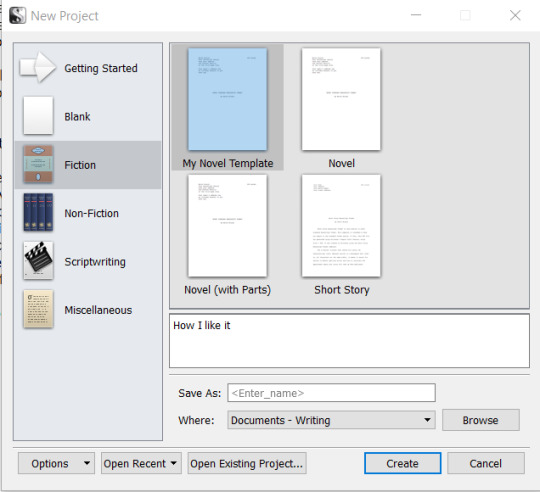
This is showing you all the templates you can choose from. I have a personal template that’s set up for how I use it. I’ve never used the non-fiction or scriptwriting ones (Like I said, I haven’t used half the features this baby has). It doesn’t really matter which one you use because you can change it all later anyway. If you aren’t sure, just go for blank.
Select blank, type your project name and where to save it, and then click create. (Tip: The project will create an entire folder with sub-documents. I like to make a folder for each project, and then put the scrivener folder in that folder, because you can’t import images that are already in the scrivener folder.) You’ll get this screen:
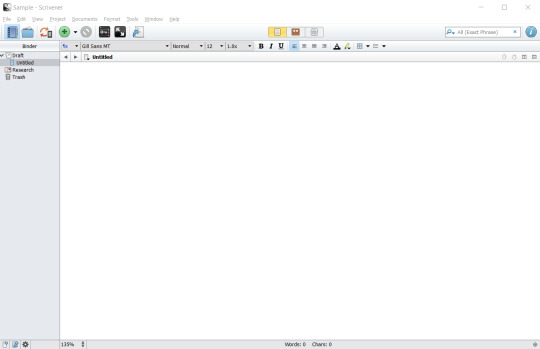
You can just start writing here. I’ll show you how I organize it though.
I like to make one folder for each chapter. Then, each scene gets its own page. You can create a new folder by click on the arrow next to the big green plus sign.
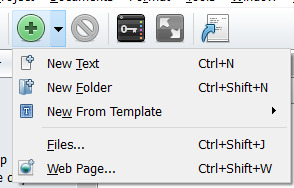
If you just click on the plus sign, it will create a new document. You can also change folders to documents and vice versa by right-clicking on them later. Create a document for each scene - basically, anywhere you’d put a page break, create a new document. They line up in order in all your folders like this:
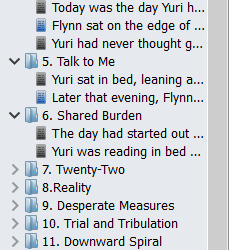
I name the folders with the chapter title. You can either name you individual scenes (i.e., “Yuri goes to the store”) or let it auto-generate a title from the first sentence of the scene. This is what I usually do. Or, if you write out of order, you could create place-holder scenes and title them with what generally will happen there once you write it.
The cool thing about this is that you can move these scenes around easily. If, for example, you decide to end a chapter earlier and want to move the last scene to the start of the next one, just click and drag it into position.
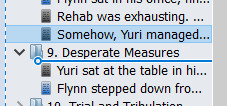
Click and drag and hover over another scene (rather than between them) to nest your document within another one. This lets you use documents as folders of their own. I usually use this for notes rather than the manuscript itself (like, one page outlining a city, and then sub-documents for neighbourhoods within it).
At any time while writing, your entire list of scenes and chapters is available at the side. Need to double-check what someone said five chapters ago? Easily find the exact scene you need to re-read by finding it in the list rather than scrolling up through thousands of words in one big document.
I like to colour-code my scenes my point of view. Yuri is black, Flynn is blue, Estelle is pink, etc. You can do this over on the right window, in this box:
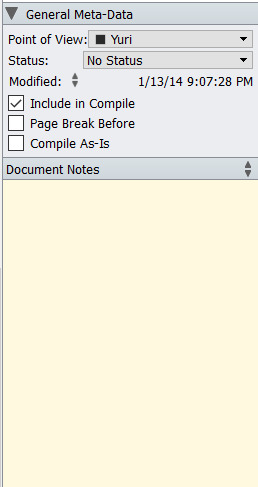
When you open a blank project, the top box there won’t say Point of View. It just says Label and will have different coloured boxes. Click the arrow and then hit “Edit...” to get to this box

Change the title of the label and create custom colour labels here. You don’t have to use this for Point of View; it’s just what works best for me.
Then, to get the colour to show up in the binder (the right bar where all your folders are listed, hit F6. That will toggle the little doc icon being coloured. F5 will toggle the colour appearing over the entire title, like this:

The Status box is for giving docs stamps - things like “DONE” or “TO DO”. It’s mostly useful in the corkboard view.
The Document Notes box is where you can write things down that pertain to just that scene. I use it to jot down a list of information that needs to be delivered in a conversation, for example, or I stick sentences I’m moving around over there until I find a better place for them. Use the arrows at the far right side to switch to Project Notes, which is like that but for the entire project and will be the same in every document.
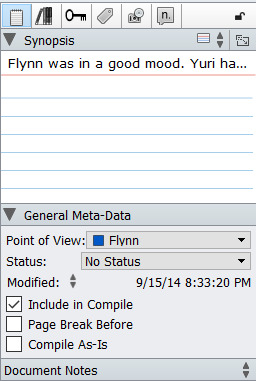
The index card at the top is where you can write a summary of the scene if you need a reminder, or if you haven’t written it yet.

The camera icon takes you to the snapshots. This is for if you’re going to make some edits but you aren’t 100% confident in them. Take a snapshot before you start and it will save the document as it is. At any time, you can go back and check your previous version of the document and use Roll Back to bring it back again. There’s a little folded corner icon on any document that has snapshots.

I never use the other tabs in the inspector here. I think they’re mostly for non-fiction writing (References, footnotes, meta data, etc). And hit the I at the top to toggle the inspector open or closed.

“Include in Compile” and related check boxes are for when you’re compiling everything into one document at the end. Don’t worry about this for fanfiction; I find it easier to just copy and paste from scrivener.
Moving on from writing, you can also keep all your research and reference notes within Scrivener so that they are easy to refer to while-writing. I put mine in the Research folder.
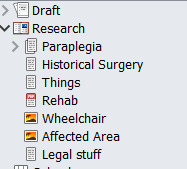
You can create documents to write things up just as you would in the Draft folder, or import image files, pdfs, even entire web pages.
Something I like to do is create a calendar. It makes it easier to keep track of the passage of time in long fics. Create a regular document, then insert a table with 7 columns and 4/5 rows. It can be as elaborate as you want. Right click on the document within the binder and go to “Change icon...” to make it stand out.

I usually don’t use the Characters or World folders for fanfic, but for original stories that’s where I put all my worldbuilding notes, character profiles, histories, etc.

These three buttons at the top control the mode you’re in. The place document is just writing mode. That’s the default. Then there’s Corkboard mode, which is how I often do outlining. Create a new folder outside of the Manuscrupt, label it “Outline” (and change the icon if you want), and then create a document for each point on your outline. If you’re in Corkboard view, creating a new document will create a new index card (which turns into a document if you go back to Editor view).

This is where those Status labels I mentioned earlier come in. I mark a thing Done on the outline to check it off. The cool thing about it is that all documents are automatically index cards. Here’s my draft showing all the folders as individual index cards:

If I move cards around on the corkboard, they automatically move around in the binder as well. So I could spread out my entire story, scene by scene, on index cards and stamp them with completeness, label the PoV character, and summaries of the contents, and then shuffle them around right here.
The last mode is Outline mode. I’m more of a visual person so I don’t use this as much. I just use it to show me how many words a chapter has because it’s the quickest way to get that info.
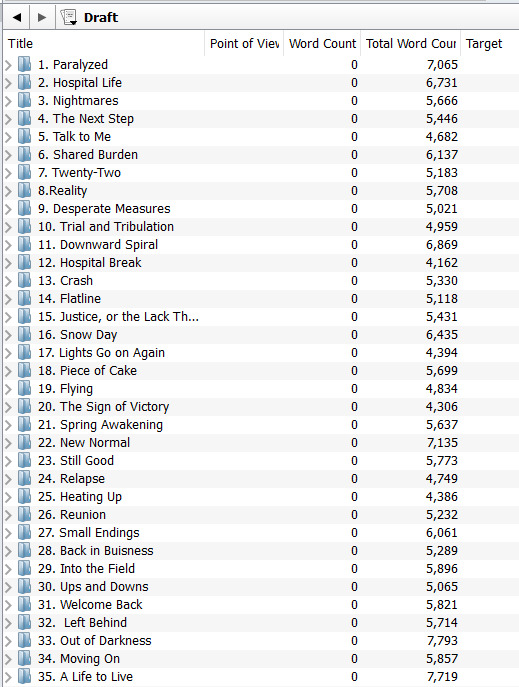
You can toggle what columns you want visible on this screen. Total Word Count isn’t there by default; you have to tell it to show that.
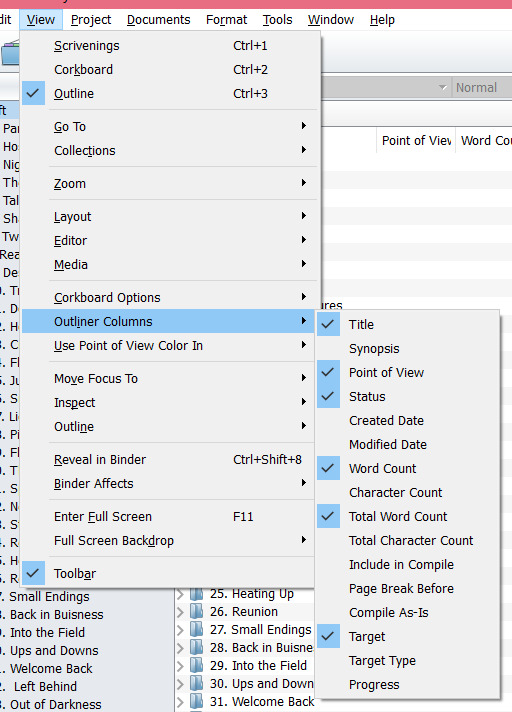
Other cool things:
The built-in Name Generator found under Tools

Go to Tools > Options to change the fonts, colours, sizes, appearances etc.
Press F11 (this button)

To enter fullscreen mode. You can change the appearance of this under Options but it lets you write in a customized fullscreen view to help concentration.

Press ctrl+shift+’ to enter split screen view. This lets you write in one window and have reference material (or another scene) open in another. ctrl+’ takes you back to one screen.

The last important thing is Typewriter scrolling. This makes it so that when you hit enter, the lines shift up and keep your writing centred on the page. You never hit the bottom of the screen, you never have to scroll up to re-centre yourself. It’s great. I only turn it off if I’m editing because then if you fix a type near the bottom of the page it snaps that to the middle and can be annoying. I always forget how to turn this on but here it is:

Honestly this is just an overview of the most important features to me. This program is huge. I’ve been using it for almost 10 years and I’m still discovering new things about it (maybe because I am a person who never reads manuals and just figures shit out as it comes up but shhhh). I love it a lot and feel free to ask me how to do a thing because I can’t write without it now.
39 notes
·
View notes
Text
LENOVO THINKPAD X1 FOLD REVIEW: A FOLDING SCREEN FILLED WITH POTENTIAL
The Lenovo ThinkPad X1 Fold is awesome… as a concept.
Come on, it’s a display that folds in half. You can carry it around like a tablet. You can prop it up and use it like a Surface Pro. You can fold it halfway and use it like a clamshell laptop. You can fold it slightly and hold it like a hardcover book. And everyone who sees you whip it out of your briefcase will ask “Wow, what’s that?” And you can tell them “Oh, nothing. Just the world’s first foldable PC.” Picture it. There’s no way you won’t feel like the coolest person in your meeting.
So should you buy it?
I mean, no. Before we get into this: definitely not. It’s a whopping $2,499, not including the stylus and keyboard. (Bundles with both accessories start at $2,749 on Lenovo’s website.) That’s more than anyone needs to spend even to get a very good laptop — and there are a few too many problems with the X1 Fold for me to put it in that category.
But! I do like the idea. The folding form factor certainly makes life easier, and I have no doubt that we’ll see more devices like this in the future — assuming manufacturers can work out some of the kinks.
A TRAVEL PRO
Here’s how a day with the X1 Fold went for me. In the morning, before signing on for work, I lay on the couch and used the Fold as a mini clamshell (that is, folded at 90 degrees with the keyboard on the bottom half of the screen) to catch up on emails. Someone had sent me an interesting YouTube video overnight. I unfolded the laptop into a 13.3-inch tablet, setting the keyboard aside, and watched it fullscreen.
Then, work time. I popped out the built-in kickstand and propped the unfolded ThinkPad up on my kitchen table, laying the keyboard out in front of it. I used multiple windows in split-screen, with Slack and Spotify over top, the way I’d use any standard 13-inch laptop. In the early afternoon, I had an hour-long Zoom meeting, so I headed back over to the couch and folded the thing into a book shape, with Zoom on one side and Slack on the other. After that, back to work — but I didn’t feel like going back to the table, so I folded the ThinkPad back into mini-clamshell mode and used it that way on the couch for the rest of the day.
This is all just to illustrate how many different uses there are for this form factor. I can’t say that a folding screen has ever been at the top of my “Laptop Features I Need” list — but after using the X1 Fold for a week, I would love to own one of these.
There’s no laptop I’d rather bring on a business trip than the X1 Fold, and that’s due to a couple of design choices in addition to the versatile form factor. For one: it’s really, really nice. The device is clad in an authentic black leather cover with a sturdy kickstand integrated into it. The ThinkPad logo adds a sleek splash of red. It all looked very out of place in my drab apartment. The only parts that look a tiny bit cheap are the bezels, which are large and rubber. Those are necessary to protect the sides of the display from clinking against each other, and they also give you something to hold while you’re using the Fold as a tablet.
A folding display also makes for a great travel companion. Folded in half, this ThinkPad is about the size of a hardcover book: 9.3 x 6.23 x 1.09 inches and 2.2 pounds (299.4 x 236 x 11.5 mm and 999g). The keyboard fits inside the folded device (magnets keep it secure), and it has a snug sleeve for the stylus on its side. I easily slipped the whole affair into my purse and would have loved carrying it around a trade show or conference under my arm. Any time I brought this somewhere, I thought, “Man, I wish I’d had this in college.”
And with the leather cover, I was never worried about bumping or scratching the Fold — something that can be stressful with devices this expensive. (Lenovo says its product underwent MIL-STD 810H testing and is resistant to conditions including humidity, dust, sand, extreme temperatures, and mechanical shock. This certainly promises a much higher level of durability than we’ve seen from folding phones thus far.)
THE FOLD
With foldable devices, there’s always one big question. The answer to that question is no: you can’t see the crease while you’re using the Fold (though it’s visible when the device is turned off). The exception is when it’s partially folded like a book. The lighting in the middle and the lighting on the sides is a bit uneven in that case. But credit where credit is due: when you’re using the Fold flat, there is no crease to be seen.
The hinge itself, which Lenovo says it spent years developing, is quite sturdy and didn’t give me any problems. The ThinkPad requires two hands and a bit of a firm tug to open. But on the plus side, it always stayed exactly in the position I put it in without any slips or wobbles.
Flat, the display is a 13.3-inch OLED with 2048 x 1536 resolution. That’s a 4:3 aspect ratio, which is unusual for a laptop but feels quite roomy compared to a traditional 16:9. I could easily stack two or even three Chrome windows side by side, often with Slack, Zoom, or another app over top, without having to zoom out. And I didn’t notice any jelly scroll (where one side of the screen is able to change pixels faster than the other side), which was a problem with some early foldable phones.
The viewing experience is a luxury. The panel reproduces 100 percent of the sRGB color gamut, 100 percent of Adobe RGB, and 95 percent of DCI-P3. It’s great for watching videos and movies; even the dock icons pop with color.
On the downside, good luck using this thing outside. Not only is it quite glossy, but it only reached 289 nits at maximum brightness. That’s not a problem for indoor work, but it’s still a bit of a letdown for the price since some premium business laptops offer 1,000-nit options for less.
PERFORMANCE AND SOFTWARE
Lenovo has come up with some neat software tricks to improve the Fold experience. There’s an app called Pen Settings where you can map the buttons on Lenovo’s stylus: they can do everything from copy / pasting to erasing, toggling music and volume, and pulling up various applications.
You can also use Lenovo’s Mode Switcher (which pops up whenever you fold or unfold the device) to split the screen in half, essentially creating two separate displays on either side of the crease. This is most useful in the mini-clamshell form if you want to have one application running up top and one on the bottom. But you can also use it when the Fold is flat, the same way you’d use the Windows split-screen feature. And if you split the screen in Mode Switcher, the Fold preserves that layout when you move between portrait and landscape orientations, whereas elaborate arrangements of tabs and apps sometimes get scattered everywhere otherwise.
These are nice touches, and they show that Lenovo has really thought through the potential this form factor has, rather than just slapping a hinge onto a Surface Pro. But when it comes to performance, there are signs that this product is still in an early stage.
There’s a lot to commend Lenovo for here. I get stressed out just thinking about the tasks this computer has. Not only does it need to know whether it’s in portrait or landscape mode (like any regular tablet), but it also has to detect whether it’s folded, how much it’s folded, and where the keyboard is — and then resize its interface accordingly. Given all that, I’m quite impressed that this thing (mostly) works.
Mostly. But it’s not seamless, and there are some areas where the Fold and Windows 10 aren’t quite seeing eye to eye yet.
For example: every so often when I had the Mini Keyboard connected, the Fold forgot it was there and sent up the on-screen keyboard anyway when I selected a textbox with the stylus. You can turn the on-screen keyboard off in Settings if this annoys you, but it’s still a glitch that’s disappointing to see. On the other hand, occasionally, the on-screen keyboard didn’t come up immediately when I wanted it to, and I’d have to prod the text box a few times before the Fold got the hint. And the little writing box, which is supposed to pop up whenever you tap a text field with the stylus, seemed to come somewhat randomly: it didn’t appear at some times when I wanted it, and it did pop up at some times when I didn’t (like if I had just highlighted something in a Google Doc).
There were two occasions, both after a restart, where the Fold didn’t realize it was in mini-laptop mode and tried to expand across the whole screen. I had to remove and replace the keyboard before the Fold detected it. (Lenovo is aware of that issue and says it’s working on a fix.)
Most annoyingly, I wasn’t able to video chat in Zoom or WebEx using mini-laptop mode because my video feed (like the tablet’s camera) was sideways. That’s not a Lenovo-specific problem — some other Windows convertibles also don’t properly rotate their cameras if you flip them around during video calls. But it’s still something I hope Zoom and WebEx are able to fix. Were it not for this issue, mini-laptop mode would be the ideal form factor for remote meetings (WebEx on the top half, notes on the bottom).
I have faith that Lenovo will iron out these kinks as time goes on. But at present, they are here.
The X1 Fold doesn’t have as heavy-duty of a processor as you’ll find in some other ThinkPads. It’s powered by the Intel Core i5-L16G7, one of Intel’s “Lakefield” CPUs. These are “hybrid” processors, efficient chips designed for small and light devices. They’re Intel’s answer to the Arm chips in phones, tablets, and now MacBooks. (Microsoft’s dual-screen Surface Neo is supposed to be getting one, too.)
Occasional glitches aside, I was pleasantly surprised by the performance here. Multitasking in a dozen apps and Chrome tabs was no problem, and I could do some scrolling and browsing during a long Zoom call without anything freezing up. Of course, that’s also true for plenty of devices you can get for a few hundred bucks.
And the Fold also dragged its feet on some tasks where other premium business laptops (not to mention high-end consumer laptops that are half this price) do better. It takes a good few seconds to boot up, for example, and I sometimes got impatient waiting for it to find things in File Explorer and send windows to fullscreen. Webpages were a bit slower than I’m used to. The ThinkPad also takes a few seconds to rearrange itself between modes — and mini-clamshell mode, in particular — but I’m willing to forgive that since it’s a brand-new use case for Windows 10.
Battery life, though, was quite disappointing. Running the X1 Fold through my sustained workload (around 12 Chrome tabs and apps, occasional Spotify and YouTube streaming and Zoom calls, 200 nits of brightness), I averaged four hours and 50 minutes on the Better Battery profile and five hours and 35 minutes on the Battery Saver profile (with Intel’s battery-saving features enabled). That’s not necessarily unexpected for a laptop with an OLED display and only a 50Whr battery. But it’s not good for a $2,500 device, especially one that’s meant to be used on the go. The Surface Pro 7, which has a higher-resolution screen, got seven to eight hours in our testing.
The final thing worth mentioning here is that Windows 10 is still a “meh” operating system for tablets. If you’ve never used a Windows tablet before, it’s quite different from using an iPad. Gesture controls are still fairly basic, especially compared to Apple’s shortcut offerings. Moreover, most Microsoft apps aren’t designed to be used on a tablet the way that iPad apps are, so you’ll be doing a lot of struggling to tap boxes and icons that are much smaller than your fingertip. And actions like rearranging tabs and dragging / dropping windows that are second-nature with a touchpad are difficult to do with your fingers.
Switching to Windows Tablet Mode helps with this a bit, but you have to dig into the Action Center to turn that on manually. The Fold doesn’t swap to it automatically when you disconnect the keyboard the way Surface Books do. (Again, it’s not a Fold-specific problem — in general, disconnecting Bluetooth keyboards from Windows convertibles doesn’t trigger Tablet Mode — but it’s inconvenient nonetheless.) And of course, Windows 10 doesn’t have any unique features that take advantage of the dual-screen setup; Microsoft is working on an operating system optimized for dual-screen hardware (including its own Surface Neo), but we don’t expect that to arrive until next spring.
The running theme here is that most of these issues are Microsoft’s fault, not Lenovo’s. The convertible laptops Microsoft makes use the same operating system. But the lack of tablet functionality makes more sense on Surface Books and Surface Pros, which can serve as tablets where needed but are still meant to function primarily as computers. The problem with the Fold is that it’s at its best as a tablet. The ideal X1 Fold customer will be using it as a tablet most of the time. Because there are two major reasons I don’t recommend this device as a primary laptop. Those reasons are...
THE KEYBOARD AND TOUCHPAD
The X1 Fold is beautiful to look at and, as a tablet, a marvel to use. But I still dreaded having to drive it for my actual work every day. That’s because the keyboard and touchpad are tiny.
Now, I understand why they’re tiny. Lenovo wanted to make a keyboard small enough to fit inside the folded device so it wouldn’t be an extra thing to carry around. And it certainly succeeded in making a keyboard that fits perfectly into the folded-up tablet. I was never concerned that it would fall out.
But I hate typing on it. The keys actually feel quite sturdy and have a satisfying click to them, but Lenovo essentially had to combine a number of keys to achieve its desired size. For example: the apostrophe / quotation key, usually to the left of Enter on a US keyboard, has been moved to the far right side of the keyboard above Enter. (It’s a half key, sharing a slot with colon / semicolon). Every time I needed to type an apostrophe, I had to consciously stretch my hand far to the right. Approximately 50 percent of my apostrophe attempts resulted in instinctively slamming Enter instead (as my colleagues who received numerous incomplete Slack messages can attest). I assume you’ll adjust to this after a while of using the Fold, but boy is there a learning curve.
It gets worse: Lenovo had to cram some keys that were already dual-purpose together, meaning that some buttons accommodate as many as four different symbols. Question mark / forward slash has been combined with period / greater than, so typing a question mark requires hitting all three of Shift, Fn, and period at the same time. Dash has been relegated to Fn+9, which also tripped me up. I had to go through this review and delete a bunch of accidental 9s I’d typed before I filed it. And backslash requires Fn+8, which would make the X1 Fold a huge pain for people in STEM fields who needs to use LaTeX and some other programming languages.
Again, I understand why the keyboard needed to be small. But I would rather carry the keyboard separately than have to press three keys to make a question mark. Lenovo could make a nice carrying case that fits the Fold, the keyboard, and the stylus, and I would be totally fine with that. The company could also create some more space by removing the touchpad — which it might as well because the touchpad is basically useless.
To put in context how tiny this thing is: if I place two fingers on it (and my fingers are quite small) there is almost no room above or below them. So as you can probably imagine, scrolling is a pain (you hit the plastic frame immediately) as is clicking / dragging, highlighting, and anything else that requires two moving fingers. (There’s nowhere close to enough room.) Laying out a big article, which involves copy-pasting text and moving a bunch of images around, was quite a struggle.
The touchpad also didn’t do what I needed it to as often as I wanted. It sometimes thought I was holding it down when I had let go, meaning I’d unintentionally move tabs around. And highlighting a segment of text or getting my cursor to land in an exact spot was often a trial-and-error process. Even with the touchpad on its lowest sensitivity, I rarely got the right location on the first go.
I don’t use third-party peripherals with laptops I review, but this touchpad pushed that principle to its limit: I have never been closer to saying “Screw it” and plugging in a mouse to give myself a break. I ended up using the stylus for most of my navigation, but that’s suboptimal for some actions (rearranging tabs, doing anything in Google Docs).
Overall, the X1 Fold is a spectacular device in a lot of ways. It’s good at the one thing it’s advertised for (folding). It’s beautiful, both to look at and to use. It’s sturdy. And the form factor is useful. It’s not a gimmick. I would love to own a tablet like this.
The key word there is “tablet.” The X1 Fold isn’t a tablet. It has a laptop operating system and — more importantly — it’s priced like a laptop. It’s priced like a very expensive laptop.
And it’s not ready to fill that role yet. The battery life isn’t there yet. The keyboard and touchpad aren’t there yet. The software integration, while commendable, isn’t there yet.
The key word there is “yet.” Because with all that being said, I can’t wait for the second generation. Samsung’s first foldable phones were riddled with issues — but just over a year and several iterations later, the company is selling a folding device that’s very usable (albeit pretty expensive). I’m sure that’s going to be the case with foldable laptops as well. Lenovo has a groundbreaking idea, with a strong foundation to build on. I really hope it’s able to patch the Fold’s glitches without compromising on the components that are already exceptional. That would be a breathtaking device, one that would earn my unambiguous recommendation.
AGREE TO CONTINUE: LENOVO THINKPAD X1 FOLD
Every smart device now requires you to agree to a series of terms and conditions before you can use it — contracts that no one actually reads. It’s impossible for us to read and analyze every single one of these agreements. But we started counting exactly how many times you have to hit “agree” to use devices when we review them since these are agreements most people don’t read and definitely can’t negotiate.
To start using the Lenovo ThinkPad X1 Fold, you’ll need to agree to the following:
A request for your region and keyboard layout
Windows 10 license agreement, Lenovo privacy statement, and Lenovo limited warranty
PIN
You can also say yes or no to the following:
Wi-Fi
Microsoft account (can be bypassed if you stay offline)
Privacy settings (speech recognition, location, Find My Device, sharing diagnostic data, inking and typing, tailored experience, advertising ID)
Customize your device for gaming, schoolwork, entertainment, creativity, family, or business
Sync an Android phone
OneDrive backup
Office 365
Allow Microsoft to collect personal information for Cortana, including location and location history, contacts, voice input, speech and handwriting patterns, typing history, search history, calendar details, content and communication history from Microsoft services, messages, and apps.
Add a Lenovo ID profile
That’s six mandatory agreements and 15 optional agreements to use the ThinkPad X1 Fold.
0 notes
Text
LoH: Trails of Cold Steel PC Guest Blog #2 from Peter “Durante” Thoman - Graphical Enhancements & Options
Welcome to the second part of this 3-part series on the PC port of Trails of Cold Steel. The first part dealt with lifting the performance of the game to a level that I consider acceptable -- great even. Of course, you might now be wondering what to do with all that performance headroom if you’re planning to play on something faster than a GPD Win. After all, there isn’t really any need to run a turn-based JRPG at 300 FPS or more.
In this article I’ll introduce the various graphical settings I’ve added to the game, going into a bit more detail on some of them. I’ve been looking forward to this one in particular, so I hope you enjoy reading it as much as I did writing it.
The Launcher
Let’s start with a look at the game’s launcher:

There are a few things I’d like to remark on:
Every single option has a description text, and often it also shows visual comparisons of the settings (on the right)
The entire launcher you see here can be navigated just using a gamepad (actually, I made a tool for this that allows natural 2D-navigation and changing options in arbitrary C# WinForms dialogs using Xinput, and XSEED has graciously agreed to allow me to open source it, so look for that on my blog when things are less hectic)
Can you spot the typo on this screenshot? It’s fixed by now.
The rest of this article will look at the options contained in the “Display”, “Image Quality”, “Shading” and “Graphics” sections of the launcher in order.
Display
Here, you have the basic choice between windowed or fullscreen rendering with or without v-sync. In terms of framerate, there are 3 settings: a 30 FPS limit, a 60 FPS limit, and unlimited FPS. While the game was 30 FPS on consoles, in the PC version both 30 and 60 are fully supported. Unlimited variable FPS also work very well in all my testing, but are not fully QA’d throughout the game and offered on a “your own risk” basis.
Finally, I’ve also added an option for adjusting the Field of View (FoV). While not as important as in first-person games, playing close to a large monitor often makes a larger Field of View desirable. Here you see a comparison between the default FoV (left) and a very high setting (I wouldn’t personally choose one this high, it’s just for illustration):
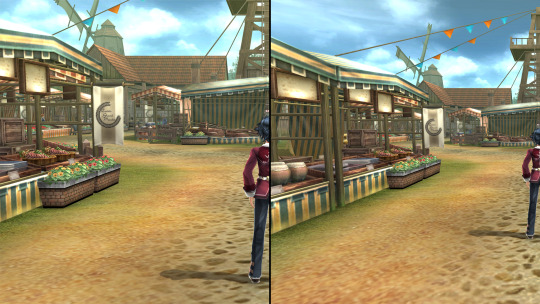
Image Quality
This section deals with resolution, anti-aliasing (AA) and texture filtering. Resolution works as you would expect. In terms of anti-aliasing, MSAA 2x, 4x and 8x are supported, and transparency supersampling (TrSSAA) is there as a high-end option to improve the quality of alpha-tested surfaces. It was strange to discover that TrSSAA is actually significantly more difficult to implement in DX11 than it is in Direct3D 9 or OpenGL, but at least that explains why so few games offer it. Here is a comparison to show what each option does -- of course, the difference is much more pronounced in motion:
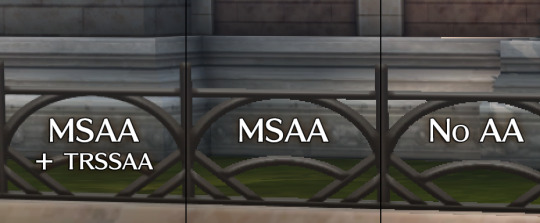
Before we move on to shading, there’s one thing I need to get off my chest. You know what really annoys me? When games offer some AA option, but do not apply that AA solution consistently to everything in the game (like e.g. character models in menus.) I had to extend the underlying engine to do it, but rest assured that when you select an AA option in Trails of Cold Steel on PC, everything will get that level of AA:
The main game rendering will be AA’d of course.
The rendered character dialogue portraits will also get the AA.
The character models shown on the equip screen? AA’d.
Character busts during special events? AA’d.
Yes, even the minimap rendering gets MSAA. And TrSSA. Because why not!
Oh, and there’s an anisotropic filtering option. It’s just a checkbox, because honestly, there’s no reason to bother with less than 16xAF for this game. Even the GPD Win can do it!
Shading
Now this is where things get even more interesting. There are four options related to the quality of dynamic shadows:
Shadow Resolution, which, as you’d expect, adjusts the resolution of the shadow maps all the way from “low” to “absurd”.

Shadow Casters, changing which objects cast shadows. Shadows are often enabled only selectively for performance reasons, with artists manually selecting which objects and characters are sufficiently “important” to cast shadows. This setting overrides that selection and makes every object in the scene cast a shadow.
Shadow Distance, which can increase the distance shadows are cast at. Ever annoyed by shadows appearing and disappearing a few meters in front of you? I know I am. Well, not on my watch.

Finally, Shadow Filtering enables softer and more aesthetically pleasing shadow transitions.
Even with these improved real-time shadows, the game’s environments still looked a bit flat. Since the environments, unlike the characters’ cel shading, are rendered and shaded in a more realistic style, I thought that a more realistic modern technique, namely ambient occlusion, might look good. With some engine improvements I was able to integrate HBAO+, one of the highest-quality and best-performing AO solutions available:

As you can see, it lends everything a lot more depth and plasticity, and also makes objects in the shadows appear more grounded.
Graphics
Last, but certainly not least, the “Graphics” options seem comparatively unexciting with just two checkboxes: and really, the High Quality Depth of Field setting just does what it says on the tin and while it’s a nice improvement, it’s nothing to write home about.
On the other hand, the Unlimited Draw Distance option is, and excuse me if I say so myself, a really big deal. In fact, doing something about the draw distance was one of the very first requests that came up when the first article was posted. What I’ve done about it is completely eliminate any form of pop-in, by making all objects and characters draw at any range. On some maps this is quite a significant extra CPU load, especially combined with full shadow casters, but nothing a modern Desktop PC can’t easily deal with.
Since pop-in is hard to demonstrate in images, I’ve made a video that really shows off the considerable effect of this option.
Other Improvements and Conclusion
In addition to these options, there are a few graphical improvements over the console version that are “always on” and don’t have a launcher option. For example, the glow effects are rendered at 4 times the fidelity, and uncompressed textures are used instead of the compressed assets designed for consoles wherever they were available.
I hope you’ll enjoy these graphical improvements as much as I enjoyed creating them and writing about them. In the final article, we’ll have a look at some non-graphical features, and one particular, somewhat programming-intensive graphical option that will make a few people really happy and which I never expected XSEED to go for. Till then!
#xseed games#xseed#xseed blog#the legend of heroes#trails of cold steel#guest post#durante#long post
134 notes
·
View notes
Text
Why Go TabletOnly
When I started using a tablet as my main device, I had no conscious reason for why beyond wanting a very portable device that I could use for writing and all the standard 'internet stuff'. Well, and of course to satisfy my need for gadgetry.
That last point is not a small one in the entire reasoning behind this venture. I remember watching Inspector Gadget as a child and being ridiculously fascinated and envious of Penny's computer book and watch, even more so than I was fascinated by the communicators and tricorders in Star Trek. There was just something about the ability to look up any kind of information at any time that appealed to me. I don't think I will have to mention what kind of hail mary the advent of mobile internet and smartphones was to me.
The first few points are much less personal and as such probably more universal. A portable device that allows for communication, leisure and work.
A lot of people use a laptop for that mostly because of that last point. Work. They are afraid they won't be able to do what they need to do without a 'real computer'.
But laptops, even small 11" ones, are still nowhere near as portable as a tablet. Even a 10" tablet is easier to transport, lighter and smaller, than a laptop. And it has something else. Something that a laptop simply does not offer.
Modularity.
That is one of my favourite aspects of a tablet over even a small laptop. I can have an almost desktop like setup with my mechanical keyboard that I can type on for hours and hours, or I can have a more mobile setup with a smaller, lighter bluetooth keyboard. Or I can use the tablet as is, holding it and carrying it around. And I can switch between those 'modes' by simply picking the tablet up out of its stand and moving it.
I can be sitting down, as I am doing right now, with the tablet in a stand and typing away at my full size mechanical keyboard writing an article one minute and just pick it up and move to bed to read a blog post the next.
Sure, you could argue that I could do the same with the combination of a laptop and a tablet or even with a laptop and a phone, but it's just not the same, it doesn't have the same fluidity to have to change between two or more devices even with services like Pocket and cloud storage. It takes more work to make what I was reading or working on available in a way to pick it up on a more portable device, then find it on that device and pick up from where I left off. Having it all in one device is so much more convenient.
And I say that as someone who is all about dedicated devices. But that is a topic for another post.
When talking about tablets, you cannot not talk about the software. Mobile OS-es and their limitations are often the first thing that people bring up when talking about why a tablet can never be a productivity device. There is the lack of multitasking and the lack of familiar, tried and true programs.
One of those things is not necessarily a downside and the other is mostly just a matter of getting out of old habits and creating a new workflow.
Lets break it down:
Multitasking.
Both Android and iOS have gotten a lot better with this lately, but it is still nowhere near the same as with window based desktop operating systems. Even with the ability to open two or three apps at a time.
But no matter what people like to believe, multitasking is not as beneficial as we'd like to think. Multitasking opens you up to distractions.
Making app switching difficult for myself and being forced to have apps open in fullscreen mode is incredibly beneficial to my productivity. It doesn't matter if I am trying to get through a long article I want to read or making a mindmap of whatever project I am working on or getting my self-imposed word count for the day in.
Of course, if your personal workflow relies on multitasking, this approach isn't for you. But the same would apply for a laptop if your personal use case is reliant on a lot of horsepower or the most screen real estate you can get.
Let's leave this debate for its own blog post and move on to the next point:
The lack of familiar applications.
Humans are, as a whole, creatures of habit and any interruption in what we know is usually met with resistance. I think that is the biggest mental hurdle for most people when considering switching to a tablet.
Getting stuck on this idea of 'but my favourite program doesn't exist on there, so it won't work for me' without considering what they want to do.
When I started using an Android tablet as my main device, Office was not available for the platform. As a writer, that was a point I was hesitant about until I realised that what I wanted from Office was simply to be able to write and format my writing.
Something a lot of apps are capable of.
Yes, it took me some trial and error to find the right app and the right way to use it for a lot of my use cases, but that was merely an initial effort and by now my workflow is set and works just as well, if not better than the one I had on Windows.
Of course, just like with the point about multitasking, if your work absolutely requires a certain application on a certain desktop OS, then this won't work for you. But the same would apply for MacOS if your application only exists on Windows.
But this post is supposed to be about Why Use a Tablet. A post about what is possible and what isn't on a tablet will follow.
So why should you consider working on a tablet?
It's light, easy to transport, modular, always on and distraction free.
If those are points that appeal to you and they aren't outweighed by any of the downsides mentioned, maybe going TabletOnly (or at least TabletMostly) is for you, just as it is for me.
0 notes